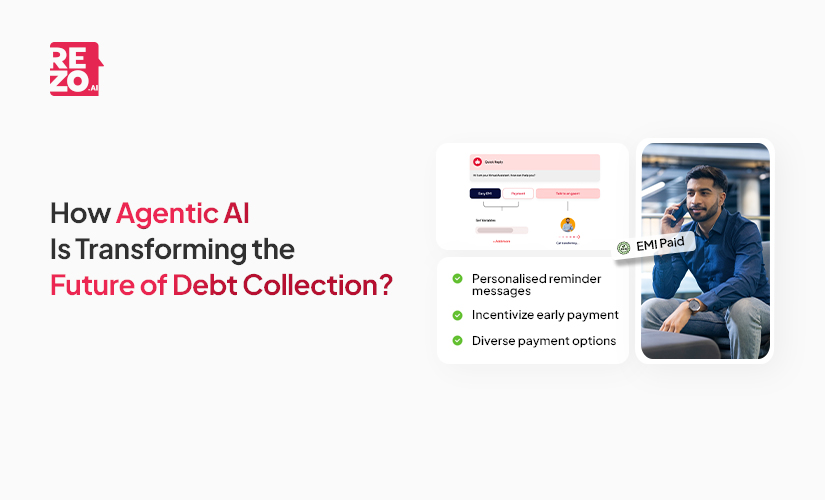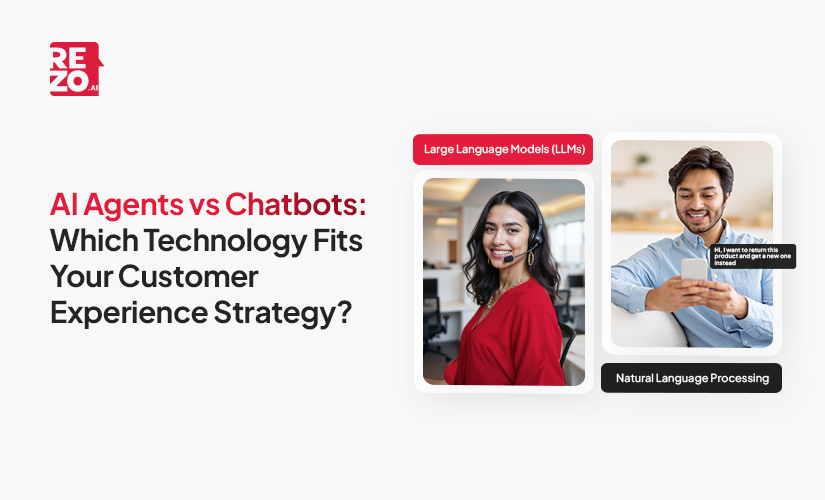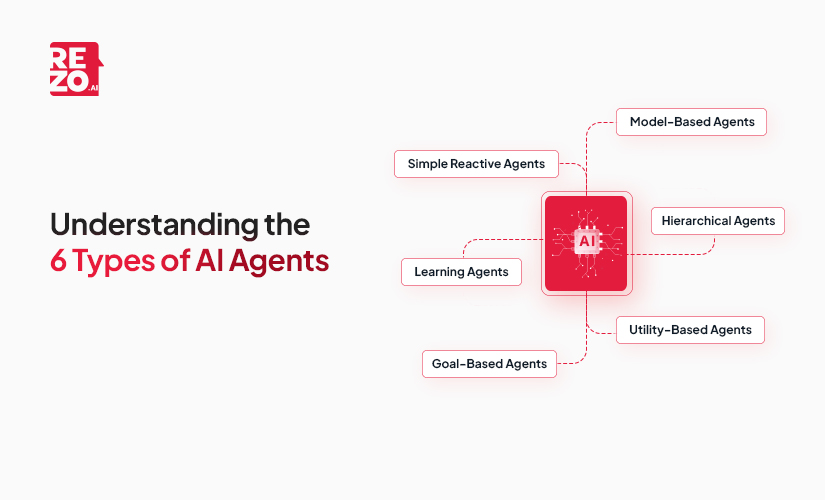
6 Types of AI Agents for your Business
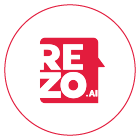
6 Types of AI Agents for your Business


The artificial intelligence revolution has fundamentally transformed how businesses operate, introducing sophisticated AI agents that can think, learn, and act with remarkable human-like intelligence. From virtual assistants scheduling meetings to complex intelligent agents making strategic business decisions, these digital workforce members are reshaping entire industries. Today's different types of AI agents harness cutting-edge technologies like machine learning (ML) and natural language processing (NLP) to deliver unprecedented automation capabilities that extend far beyond simple task execution.
The business impact is undeniable. According to McKinsey's latest 2025 State of AI report, 78% of organizations now use AI in at least one business function, a remarkable jump from 72% in early 2024 and just 55% in early 2023, demonstrating the accelerating pace of AI adoption across industries. This technology adoption is directly translating into measurable outcomes: increased revenue streams, enhanced operational efficiency, and elevated customer experiences that set market leaders apart from their competition.
But what makes these AI agents work so effectively, and how do the different types of AI agents adapt to serve diverse business needs across dynamic environments?
What are AI Agents?
AI agents, or artificial intelligence agents, represent a breakthrough in autonomous computing, sophisticated programs that don't just follow pre-written scripts but actually simulate human-like reasoning to perform complex tasks and make intelligent decisions. These intelligent agents employ advanced artificial intelligence algorithms to analyze vast amounts of data, extract meaningful patterns, learn from experience, and interact seamlessly with their environment to accomplish specific objectives.
Unlike traditional software that requires constant human input, AI agents perceive their surroundings through various sensors (data inputs, user interactions, environmental signals) and respond through actuators (actions, recommendations, automated processes). This sensor-actuator model enables them to function as truly autonomous entities that can adapt and evolve based on real-world feedback.
Key Characteristics That Define AI Agents
- Autonomy: These intelligent agents operate independently, making informed decisions and executing actions without requiring constant human oversight. They can analyze situations, weigh options, and choose optimal paths forward essentially functioning as digital employees that never need breaks.
- Adaptability: AI agents continuously learn from new data and experiences, refining their behavior and decision-making processes as circumstances change. This learning element allows them to become more effective over time, adapting to evolving business requirements and user preferences.
- Intelligent Interaction: Modern AI agents can engage with their environment, other systems, and human users through multiple communication channels such as text, voice, visual inputs, and API integrations. This versatility enables seamless integration into existing business workflows.
- Goal-Oriented Performance: Each AI agent is designed with specific objectives in mind, whether that's optimizing customer support responses, analyzing market data for investment decisions, or coordinating with multiple agents in complex automated systems. Their utility function drives them toward achieving measurable outcomes that align with business goals.
Types of AI Agents
The landscape of AI agents encompasses a remarkable spectrum of capabilities, from streamlined rule-based systems to sophisticated machine-learning powerhouses. Understanding the various types of AI agents available enables businesses to select the perfect digital workforce members for their specific operational needs. Let's explore how each category of intelligent agents can transform your business processes and drive measurable results.
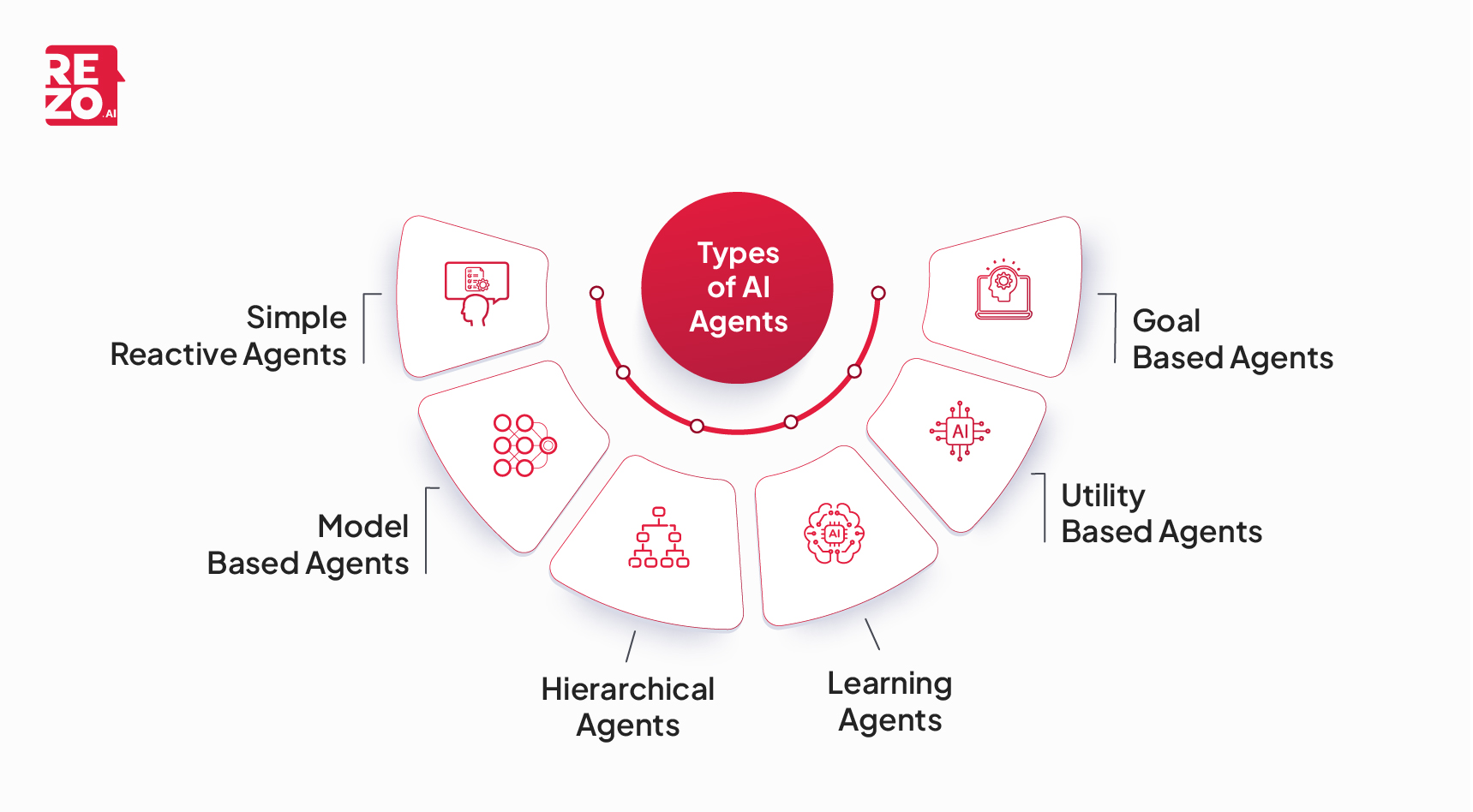
Simple Reactive Agents
Simple reactive agents, also known as reflex agents, represent the foundation of AI-powered business automation. These AI agents excel at delivering immediate, rule-based responses to customer interactions and business processes. While they may not possess complex learning capabilities, their speed and reliability make them invaluable for handling high-volume, routine operations that form the backbone of customer service excellence.
Unlike reflex agents of the past that were purely mechanical, today's simple reactive agents integrate natural language processing to understand context and provide more nuanced responses within their operational parameters.
Strategic Business Applications
Modern businesses leverage simple reactive AI agents across numerous critical touchpoints:
Customer Engagement & Support
- Automated customer service chatbots that resolve common inquiries instantly
- Intelligent appointment scheduling systems that optimize resource allocation
- Real-time order status and tracking notifications that enhance transparency
Operational Efficiency
- Basic data analysis and reporting that provides immediate business insights
- Virtual shopping assistants that guide customers through product selections
- Automated inventory management systems that prevent stockouts and overstocking
Business Intelligence & Growth
- Language translation and localization services for global market expansion
- Automated surveys and feedback collection that capture customer sentiment
- Lead qualification systems that identify high-value prospects
- Streamlined data entry and record-keeping that eliminates manual errors
- Basic financial transaction processing that ensures accuracy and speed
How Simple Reactive AI Agents Work
These reflex agents operate on sophisticated yet straightforward decision-making frameworks. When customer inputs or business triggers occur, the agents instantly analyze the information against their predefined rule sets and deliver appropriate responses. This utility function ensures that every interaction serves a specific business purpose while maintaining consistency and accuracy.
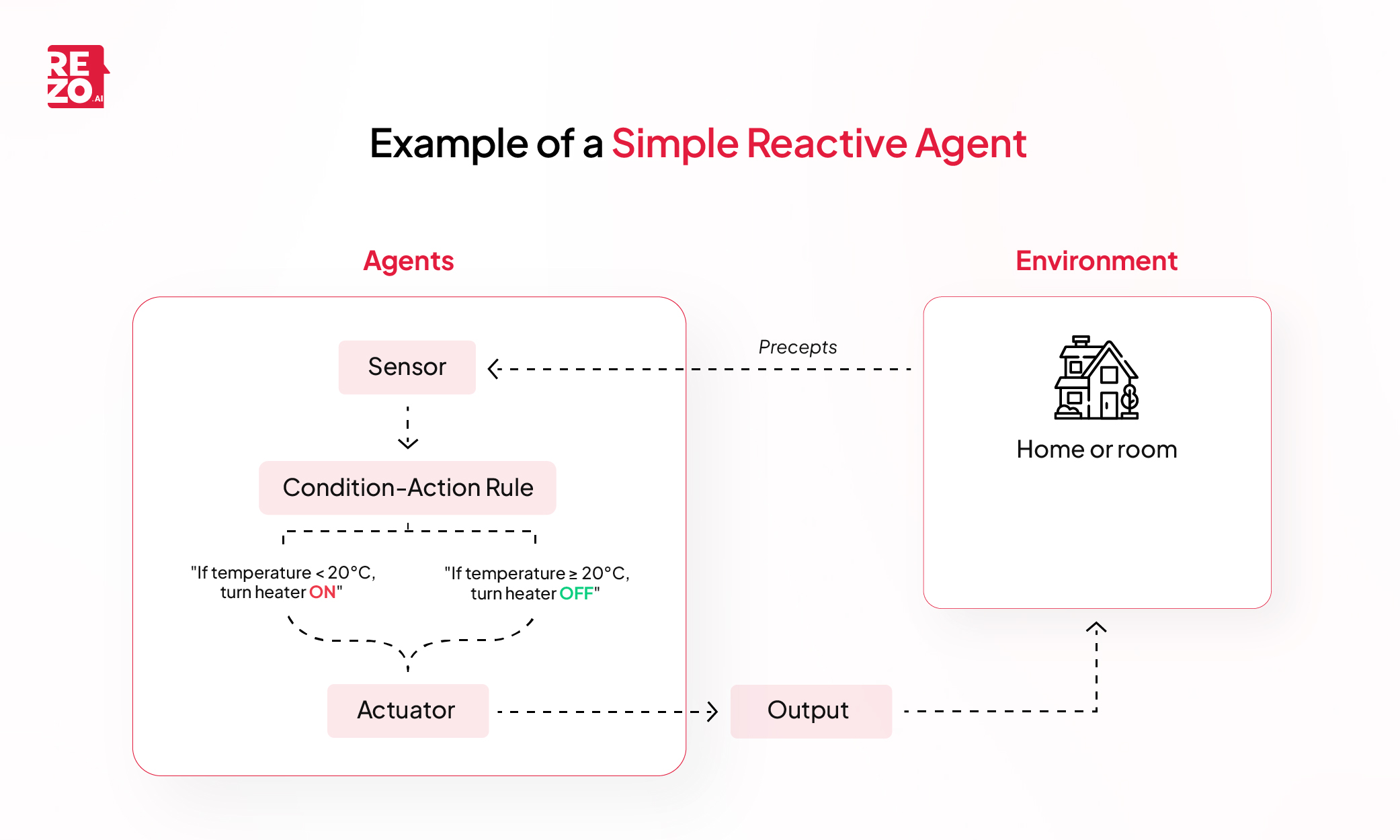
By integrating machine learning algorithms and natural language processing capabilities, modern simple reactive AI agents can interpret customer queries in real-time, understand context and intent, and provide meaningful responses that feel natural and helpful, all while operating within dynamic environments that require immediate adaptation.
Strategic Advantages
Simple reactive AI agents are game-changers for businesses looking to level up their customer service without breaking the bank. They're incredibly fast, we're talking instant responses that make customers happy instead of frustrated and they never have an off day, delivering the same quality service every single time. The best part? They handle all those routine questions and tasks automatically, which means your human team can focus on the really important stuff while these intelligent agents work around the clock. Plus, as your business grows, they scale right along with you without needing extra training or resources.
Understanding the Limitations
Now, let's be honest, reflex agents aren't miracle workers. They're fantastic at handling straightforward situations, but when customers throw them a curveball or ask something really complex, they might need backup from more advanced types of AI agents or your human team. They're also only as good as the information you feed them, so you'll need to keep their knowledge base fresh and up-to-date. And while they're efficient, they're not great at that personal touch though you can definitely pair them with smarter intelligent agents or add some contextual data to make interactions feel more customized.
Model-Based Agents
Model-based reflex agents represent a significant leap forward in AI sophistication, offering businesses the power to navigate complex scenarios with unprecedented strategic insight. Unlike reflex agents that simply respond to immediate stimuli, these advanced intelligent agents maintain comprehensive internal representations of their operating environment, enabling them to simulate multiple scenarios, predict outcomes, and optimize decision-making processes before taking action.
These sophisticated AI agents excel in dynamic environments where traditional rule-based systems fall short, making them invaluable for businesses requiring strategic foresight and complex problem-solving capabilities. Their utility function extends far beyond simple automation, they actively contribute to competitive advantage through predictive intelligence and scenario modeling.
Enterprise-Grade Applications: Where Model-Based AI Agents Drive Results
Strategic Business Forecasting
- Demand forecasting that anticipates market fluctuations and consumer behavior patterns
- Resource allocation optimization that maximizes efficiency across departments and projects
- Pricing strategy optimization that balances profitability with market competitiveness
Financial Intelligence & Risk Management
- Advanced portfolio management that adapts to market volatility in real-time
- Comprehensive risk assessment and management across all business operations
- Intelligent loan approval and credit scoring that minimizes default rates while expanding access
Marketing & Human Capital Optimization
- Marketing campaign planning that predicts ROI across multiple channels and audience segments
- Employee performance prediction that enables proactive talent development and retention strategies
Specialized Industry Applications
- Healthcare treatment planning that considers multiple variables and patient-specific factors
- Complex operational planning that coordinates multiple autonomous agents for maximum efficiency
How Model-Based AI Agents Work
These AI agents work by constructing and maintaining sophisticated internal models of their operational environment essentially creating digital twins of real-world systems. This internal representation serves as a testing ground where the agent can run countless simulations, exploring different action paths and their potential consequences before committing to any real-world decisions.

The process begins with environmental analysis, where the agent continuously gathers data to build and refine its world model. Next comes scenario simulation, where multiple potential actions are tested against this model to predict outcomes. Finally, the utility function evaluates these predicted outcomes against business objectives, enabling the agent to select the optimal course of action.
This approach allows model based reflex agents to operate effectively in dynamic environments where conditions change rapidly and decisions have long-term implications. Their learning element continuously updates the internal model based on new information and observed results, creating increasingly accurate predictions over time.
Strategic Advantages
Model-based reflex agents are like having a crystal ball for your business they don't just react to what's happening now, they actually think ahead and consider all the ripple effects of their decisions. What's really cool is that they can run thousands of "what if" scenarios in seconds, letting you test out strategies without any real-world risk. When market conditions suddenly shift (and we all know how often that happens), these intelligent agents quickly update their understanding and pivot their approach. Unlike reflex agents that need tons of historical data to work well, model-based systems are smart about building accurate pictures of your business environment, making them perfect even if you don't have years of data sitting around.
Implementation Considerations
You'll need some serious expertise upfront to create accurate models, and it does require a decent investment but most businesses find it pays off big time, especially when you're running multi agent systems that can share insights. These intelligent agents are only as good as their models, so you'll want to keep refining and updating them regularly (think of it as ongoing maintenance that actually improves your ROI). They also need some serious computing power for all those simulations, but with today's cloud solutions, that's becoming much more manageable. The one thing to keep in mind is that while they're fantastic in predictable environments, you might want to pair them with other types of AI agents when dealing with completely wild, unpredictable situations.
Learning Agents
Learning agents represent the pinnacle of adaptive AI agents, possessing the revolutionary capability to continuously evolve and improve their performance through experience. These sophisticated intelligent agents go beyond static programming they actively learn from data, adapt to changing conditions, and become increasingly effective over time. The learning element embedded within these systems transforms them from simple tools into strategic partners that grow smarter alongside your business.
Unlike reflex agents that operate within fixed parameters, learning AI agents thrive in dynamic environments where change is constant and adaptation is essential for success. Their utility function continuously optimizes based on accumulated knowledge, making them invaluable for businesses operating in competitive, fast-moving markets where yesterday's strategies may not guarantee tomorrow's success.
Strategic Business Applications: Where Learning Agents Drive Competitive Advantage
Customer Intelligence & Personalization
- Advanced customer segmentation that identifies nuanced behavioral patterns and preferences
- Personalized recommendations that adapt to individual customer journeys and evolving tastes
- Dynamic sentiment analysis that captures real-time brand perception and customer emotions
Risk Management & Fraud Prevention
- Sophisticated fraud detection systems that learn from emerging threat patterns
- Predictive churn prediction models that identify at-risk customers before they leave
- Continuous risk assessment that adapts to new market conditions and regulatory changes
Operational Excellence & Optimization
- Dynamic pricing strategies that respond to market conditions, competitor actions, and demand fluctuations
- Inventory management optimization that balances carrying costs with service levels
- Predictive maintenance systems that prevent equipment failures before they occur
Human Capital & Quality Enhancement
- Intelligent employee training and skill enhancement programs that adapt to individual learning styles
- Advanced quality control systems that improve accuracy through continuous feedback loops
- Language translation improvement that becomes more nuanced with every interaction
How These AI Agents Work

Learning AI agents work through sophisticated knowledge acquisition systems that mirror and often surpass human learning capabilities. These intelligent agents employ three primary learning methodologies to continuously enhance their performance:
- Supervised Learning Architecture: These agents learn from labeled examples and historical data, recognizing patterns and making increasingly accurate predictions. Like having a mentor guide their development, supervised learning enables AI agents to understand cause-and-effect relationships within your business environment.
- Unsupervised Learning Discovery: Operating independently, these intelligent agents explore data to uncover hidden patterns, relationships, and structures that humans might miss. This capability proves invaluable for discovering new market opportunities, customer segments, or operational efficiencies.
- Reinforcement Learning Optimization: Through interaction with dynamic environments, these AI agents receive feedback on their actions and learn optimal strategies through trial and refinement. This approach enables them to develop sophisticated decision-making capabilities that improve with every interaction.
The integration of these learning approaches allows multiple agents within multi agent systems to share knowledge and collectively improve performance across entire business operations.
Transformative Business Advantages
Learning AI agents are like having employees who never stop getting better at their jobs. They automatically adapt to market changes, customer behavior shifts, and new challenges without you having to retrain them. These intelligent agents can crunch through data volumes that would make human analysts cry, spotting insights and opportunities in real-time while getting smarter with every interaction. What's really impressive is how they make decisions based purely on data rather than gut feelings or personal biases, consistently delivering objective recommendations that actually improve your bottom line. The learning element means they don't just maintain their performance—they get exponentially better over time.
Strategic Implementation Considerations
Learning AI agents are hungry for quality data, so you'll need solid data collection and management systems in place. They also need some serious computing power, especially for multi agent systems, though cloud platforms and AI-as-a-Service options have made this much more accessible for businesses of all sizes. One thing to watch out for is bias since these intelligent agents learn from historical data, they might pick up old prejudices, so you'll want ethical AI frameworks and bias detection in place. Some advanced algorithms can be "black boxes," but explainable AI techniques help you understand their reasoning, which builds trust with stakeholders. The real magic happens when you integrate them with other types of AI agents and existing systems, that's when multiple autonomous agents work together to create comprehensive business intelligence ecosystems.
Utility-Based Agents
Utility-based agents represent the strategic intelligence layer of AI agents, making calculated decisions by precisely measuring and maximizing the value of every possible outcome. These sophisticated intelligent agents don't just consider what might happen, they evaluate the actual business value each scenario delivers, ensuring every decision aligns with organizational priorities and measurable objectives.
Unlike reflex agents that respond to immediate stimuli, utility-based agents leverage advanced utility function calculations to weigh trade-offs, assess risks, and select optimal paths that deliver maximum business value across dynamic environments.
Strategic Business Applications
Financial & Investment Intelligence
- Investment portfolio management that balances risk against return potential
- Marketing budget allocation that maximizes ROI across channels and campaigns
- Vendor selection that optimizes cost, quality, and reliability metrics
Operational Excellence
- Supply chain optimization that minimizes costs while maintaining service levels
- Staff scheduling that balances labor costs with productivity requirements
- Energy consumption management that reduces costs while maintaining operational efficiency
Strategic Planning & Resource Allocation
- Product feature selection that prioritizes development resources for maximum market impact
- Project prioritization that aligns initiatives with strategic business objectives
- Customer segmentation for promotions that maximizes conversion rates and profitability
- Inventory replenishment that optimizes carrying costs against stockout risks
How Utility-Based Agents Work
The utility based agents operate through sophisticated value calculation engines that analyze potential outcomes and assign precise utility scores based on business objectives. Their utility function serves as the decision-making compass, ensuring every action maximizes measurable value.
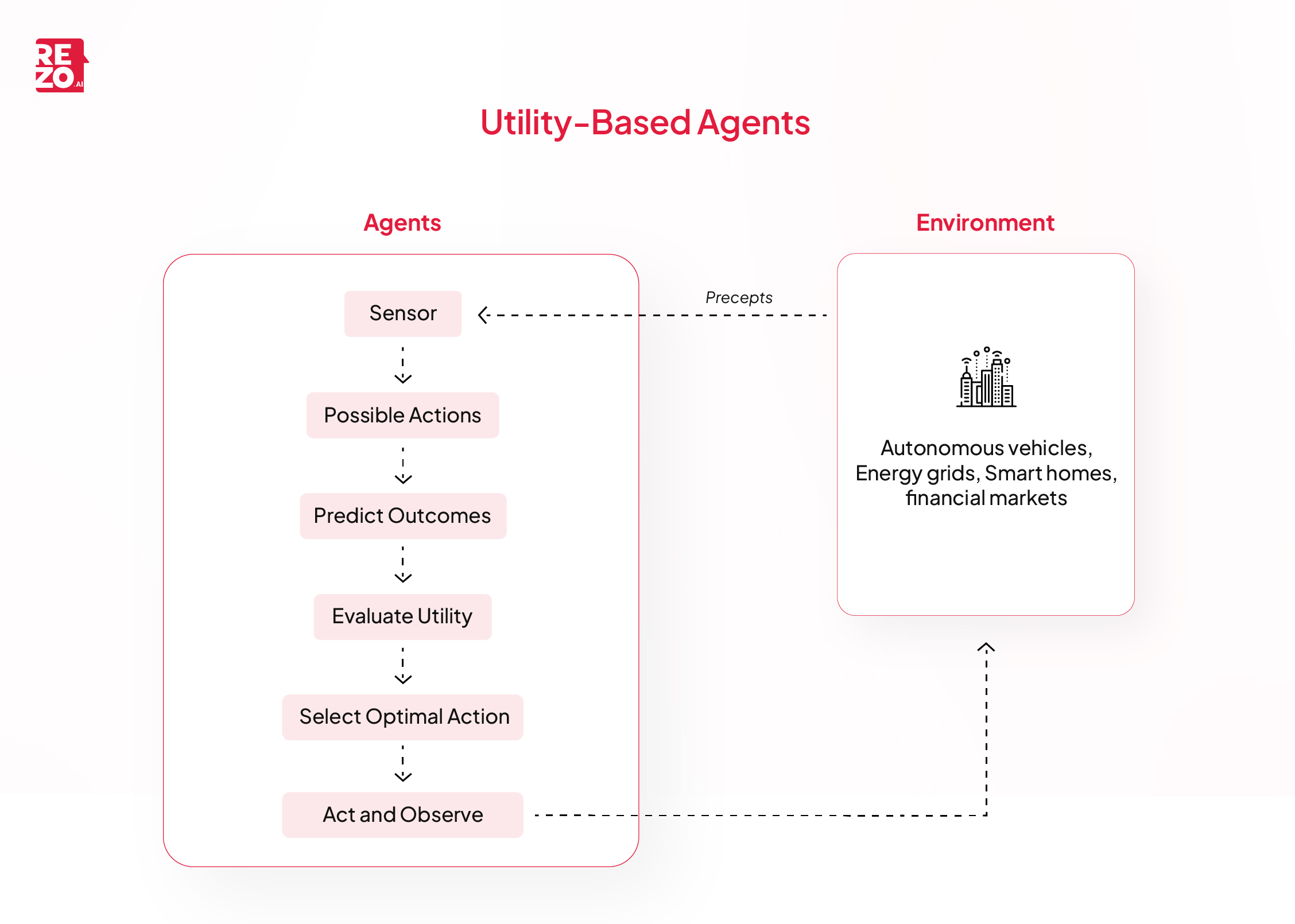
The process involves comprehensive data analysis, outcome evaluation, and utility calculation across multiple scenarios. By comparing expected utilities of different actions, these AI agents work to identify optimal decisions that deliver maximum strategic value in complex business environments.
Strategic Advantages
Utility based agents are like having a super-smart financial advisor for every business decision. They mathematically evaluate all possible outcomes and consistently pick the options that deliver maximum value for your specific goals. What's great about these AI agents is how they roll with the punches in dynamic environments, quickly adapting their decisions when conditions change while never losing sight of what matters most to your business. You can customize each utility function to perfectly match your priorities, whether that's maximizing profit, minimizing risk, or balancing multiple objectives. The result? These AI agents become masters at optimizing resource allocation, budget distribution, and task prioritization, turning every decision into measurable business impact.
Implementation Considerations
Setting up utility based agents isn't exactly simple. You'll need to build sophisticated utility functions and have decent computational infrastructure, but the payoff through optimized decision-making usually makes it worthwhile. The trick is getting your utility measures spot-on so they actually reflect what your business cares about. These types of AI agents work best when your objectives can be measured and compared numerically, making them perfect for data-driven organizations with clear KPIs. You'll also need solid, accurate data since utility calculations depend on good information but integrating with multi agent systems and robust data pipelines helps ensure everything runs smoothly in complex business environments.
Goal-Based Agents
Goal-based agents represent the strategic commanders of AI agents, possessing sophisticated planning capabilities that enable them to navigate complex challenges and execute multi-step strategies to achieve specific business objectives. These intelligent agents combine advanced reasoning with strategic planning to determine optimal action sequences that consistently deliver desired outcomes across diverse business scenarios.
Unlike reflex agents that respond to immediate stimuli, goal-based agents maintain a clear vision of desired end states and systematically work backward to create actionable roadmaps for success. Their strategic approach makes them invaluable for complex business operations requiring coordinated planning and execution across dynamic environments.
Business Applications
Revenue Generation & Market Expansion
- Sales and marketing optimization that coordinates campaigns across channels to maximize conversion rates
- Customer service enhancement that systematically improves satisfaction scores and retention metrics
- Product and service innovation that aligns development efforts with market demands and competitive positioning
Operational Excellence & Efficiency
- Supply chain management that orchestrates complex logistics networks to optimize delivery and costs
- Process automation that streamlines workflows while maintaining quality standards
- Advanced data analytics and insights that transform information into strategic business intelligence
Strategic Business Management
- Financial decision-making that balances risk, return, and liquidity across investment portfolios
- Human resources and talent management that aligns workforce capabilities with business objectives
- Risk management that proactively identifies and mitigates potential threats to business continuity
How Goal-Based Agents Work
These agents operate through sophisticated strategic planning frameworks that mirror executive-level decision-making processes. Goal-based agents work by establishing clear objective definitions, analyzing current business states, and systematically generating action sequences that bridge the gap between current reality and desired outcomes.
The process begins with environmental assessment, where agents analyze current business conditions and available resources. Next comes strategic planning, utilizing state-space search algorithms, rule-based reasoning, and optimization techniques to identify optimal pathways. Finally, continuous evaluation ensures that AI agents adapt their strategies as conditions change while maintaining focus on ultimate objectives.
When deployed as multiple agents within multi agent systems, these intelligent agents can coordinate complex, multi-departmental initiatives that require synchronized execution across various business functions.
Strategic Advantages
Goal-based agents maintain unwavering focus on your defined objectives while using data-driven insights to optimize how they get there. These agents are fantastic at adapting their tactics when market conditions shift, but they never lose sight of the bigger picture or let changing circumstances derail your business objectives. What's really impressive is their real-time strategic assessment abilities, they can instantly evaluate whether each potential action actually moves the needle toward your goals, ensuring nothing wastes resources or goes off-track. The result is superior resource optimization and cost efficiency, as they systematically evaluate every action sequence against your objectives to deliver maximum strategic ROI.
Implementation Strategy Considerations
Here's the thing about goal-based agents, they need you to really understand your business environment and operational context upfront. Success hinges on having crystal-clear, measurable objectives that actually align with your broader business strategy, especially when you're running multiple AI agents that need to work together seamlessly. You'll need a significant upfront investment in development and training. While these AI agents are excellent at achieving specific objectives, you might want to integrate them with other AI agents or deploy multiple agents to make sure you're covered when business priorities evolve or unexpected opportunities pop up.
Hierarchical Agents
Hierarchical agents represent the organizational masterpiece of AI agents, creating sophisticated command structures that mirror successful business hierarchies. These advanced agents excel at managing complex operations by distributing tasks across multiple organizational levels, ensuring efficient resource allocation and strategic coordination. Unlike simple reflex agents that operate independently, hierarchical systems leverage multiple agents working in coordinated layers to tackle enterprise-scale challenges.
This multi agent systems approach enables businesses to handle intricate operations through structured delegation, where each level contributes specialized expertise while maintaining alignment with overarching strategic objectives across dynamic environments.
Strategic Enterprise Applications
Revenue & Growth Operations
- Sales and marketing optimization with coordinated campaigns across regional and functional teams
- Customer service enhancement through tiered support structures that escalate intelligently
- Product and service innovation managed through cross-functional development hierarchies
Operational Excellence
- Supply chain management coordinating suppliers, logistics, and distribution networks
- Process automation with intelligent task delegation and quality oversight
- Data analytics and insights processing information through specialized analytical layers
Strategic Management
- Financial decision-making with risk assessment, analysis, and executive approval workflows
- Human resources and talent management through structured recruitment, development, and performance systems
- Risk management with detection, assessment, and mitigation protocols across organizational levels
How Hierarchical AI Agents Work
These agents operate through sophisticated organizational structures where each hierarchical level handles specific responsibilities while maintaining seamless communication channels. Hierarchical AI agents work by creating specialized modules at different organizational levels. Operational agents handle detailed tasks, supervisory agents coordinate activities, and executive agents make strategic decisions.
Lower-level intelligent agents focus on specific, detailed operations, while higher-level agents coordinate multiple agents and maintain strategic oversight. This structure enables multi agent systems to distribute workload effectively, with each level contributing specialized capabilities while sharing information and feedback to optimize overall performance.
Communication protocols between levels facilitate real-time information sharing, performance feedback, and strategic decision-making, creating a cohesive intelligence network that adapts to changing business requirements.
Strategic Business Advantages
Hierarchical AI agents are masters at breaking down massive, complex business challenges into bite-sized pieces that multiple agents can tackle systematically. The beauty of these agents is their modular design, which means you can add new capabilities and scale up without having to rebuild everything from scratch. They're incredibly smart about resource allocation too, strategically distributing tasks among agents to maximize efficiency while cutting out redundancy and waste. What really sets them apart is their collaborative decision-making approach. Lower-level AI agents handle the detailed analysis while higher-level agents keep the big picture in focus and coordinate everything seamlessly.
Implementation Strategy Considerations
Setting up hierarchical multi agent systems requires sophisticated planning to make sure all the agents communicate and coordinate properly. The key is nailing the information flow between hierarchical levels, because when these agents can share information efficiently, they create incredibly fast and accurate decision-making networks across your entire organization. While they work great in structured environments, you might need to add some adaptive learning elements or hybrid approaches to keep them effective in dynamic environments.
AI agents Vs Human Agents
AI agents can increase work efficiency and precision in decision-making by five folds. Various types of agents in AI are now growing their capabilities and helping human agents. They can now aid in a diverse range of business tasks, from simple customer query resolution to complex decision-making and problem-solving in businesses. AI’s computational prowess is leading to a paradigm shift that has far-reaching implications across various domains and industries.
The development and adoption of AI agents has introduced significant shifts in several aspects of the workforce. While machines cannot yet fully replace humans, AI agents can perform certain tasks and activities more efficiently, accurately, and consistently than their human counterparts. Here are some of the key differences between AI agents and human agents:
Advantages of AI Agents:
- Efficiency: AI agents can handle repetitive workloads and can provide 24/7 service without breaks. This feature promotes consistency and minimizes the potential for errors, increasing productivity.
- Accuracy: AI agents analyze data and execute commands with high accuracy, as they are bound to specific rules programmed into them.
- Faster Decisions: AI agents can analyze data and make decisions in real-time or within seconds, eliminating the need for humans to process such a high volume data.
- Cost-Saving: Since AI agents can work endlessly, they can save costs over time in operations that require long hours. This feature makes them an attractive option for businesses with high operational costs.
Advantages of Human Agents:
- Empathy: Human agents can readily discern human emotions and provide appropriate responses and assistance that to an extent, cannot be replicated by machines.
- Critical Thinking: Humans have the ability to think creatively and critically, which allows them to solve complex problems efficiently and using varied approaches.
- Flexibility: Humans have the ability to adapt to unforeseen circumstances, which makes them a better option for multiple tasks within a context.
- Contextual Understanding: Humans have a better experience in understanding nuances of human society context and handling delicate situations that require in-depth reasoning skills.
Where is the balance?
While AI agents have the potential to outperform humans in specific tasks, there are shared capabilities and limitations. While humans will likely continue playing a vital role in the workforce, AI agents are expected to offer improved support services to humans, enhancing the efficiency and effectiveness of human work.
To get the full benefits out of AI agents and human agents, we need to understand where each is best used. AI agents are better suited for routine, high-volume tasks with limited cognitive requirements, while humans excel at tasks that need contextual understanding, empathy, and critical thinking. Combining the areas in which human and AI agents excel may allow businesses to deliver fast and optimized solutions, while allowing both AI agents and human agents to provide the utmost quality service to customers and companies alike.
Frequently Asked Questions
How many AI agents are there?
There are a number of AI agents available based on their degree of intelligence and capabilities. Five major types of intelligent agent in AI are: Simple Reactive agents, Model-based agents, Learning agents, Utility-based agents, and Goal-based agents.
What is an example of an AI agent?
AI agents are artificially developed software programs that emulate certain aspects of human intelligence to carry out designated tasks. The most common examples of AI agents are Alexa and Siri. They utilise sensors to perceive user queries and commands, employing natural language processing to understand and interpret spoken or typed input. These AI agents then provide relevant responses or perform tasks based on their programming and the data they have access to.
What are the uses of AI agents?
There are different types of agents in AI that have a wide range of uses. These agents use powerful language models like GPT-3 to understand objectives, devise tasks, and carry them out effectively. They are used to automate procedures and delegate complex cognitive tasks, effectively forming a team of virtual colleagues alongside human equivalents.
Frequently Asked Questions (FAQs)

Take the leap towards innovation with Rezo.ai
Get started now







